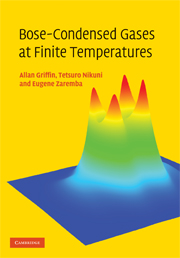Book contents
- Frontmatter
- Contents
- Preface
- 1 Overview and introduction
- 2 Condensate dynamics at T = 0
- 3 Coupled equations for the condensate and thermal cloud
- 4 Green's functions and self-energy approximations
- 5 The Beliaev and the time-dependent HFB approximations
- 6 Kadanoff–Baym derivation of the ZNG equations
- 7 Kinetic equation for Bogoliubov thermal excitations
- 8 Static thermal cloud approximation
- 9 Vortices and vortex lattices at finite temperatures
- 10 Dynamics at finite temperatures using the moment method
- 11 Numerical simulation of the ZNG equations
- 12 Simulation of collective modes at finite temperature
- 13 Landau damping in trapped Bose-condensed gases
- 14 Landau's theory of superfluidity
- 15 Two-fluid hydrodynamics in a dilute Bose gas
- 16 Variational formulation of the Landau two-fluid equations
- 17 The Landau–Khalatnikov two-fluid equations
- 18 Transport coefficients and relaxation times
- 19 General theory of damping of hydrodynamic modes
- Appendix A Monte Carlo calculation of collision rates
- Appendix B Evaluation of transport coefficients: technical details
- Appendix C Frequency-dependent transport coefficients
- Appendix D Derivation of hydrodynamic damping formula
- References
- Index
8 - Static thermal cloud approximation
Published online by Cambridge University Press: 06 October 2009
- Frontmatter
- Contents
- Preface
- 1 Overview and introduction
- 2 Condensate dynamics at T = 0
- 3 Coupled equations for the condensate and thermal cloud
- 4 Green's functions and self-energy approximations
- 5 The Beliaev and the time-dependent HFB approximations
- 6 Kadanoff–Baym derivation of the ZNG equations
- 7 Kinetic equation for Bogoliubov thermal excitations
- 8 Static thermal cloud approximation
- 9 Vortices and vortex lattices at finite temperatures
- 10 Dynamics at finite temperatures using the moment method
- 11 Numerical simulation of the ZNG equations
- 12 Simulation of collective modes at finite temperature
- 13 Landau damping in trapped Bose-condensed gases
- 14 Landau's theory of superfluidity
- 15 Two-fluid hydrodynamics in a dilute Bose gas
- 16 Variational formulation of the Landau two-fluid equations
- 17 The Landau–Khalatnikov two-fluid equations
- 18 Transport coefficients and relaxation times
- 19 General theory of damping of hydrodynamic modes
- Appendix A Monte Carlo calculation of collision rates
- Appendix B Evaluation of transport coefficients: technical details
- Appendix C Frequency-dependent transport coefficients
- Appendix D Derivation of hydrodynamic damping formula
- References
- Index
Summary
The collective oscillations of a condensate at zero temperature are well described by the solutions of the linearized time-dependent Gross–Pitaevskii (GP) equation of motion for the condensate wavefunction Φ(r, t). At finite temperatures, however, the condensate dynamics is modified by interactions with the noncondensate atoms that comprise the thermal cloud. To account for these interactions in detail involves a sophisticated numerical analysis, which will be described in Chapter 11. However, some qualitative understanding of the effect of collisions between the condensate and noncondensate components can be gained by treating the thermal cloud within an approximation that ignores its dynamics. This approximation, referred to as the static thermal cloud approximation, is the topic of the present chapter. As explained in more detail below, it is defined by the assumption that the condensate moves in the presence of a thermal cloud that remains in a state of thermal equilibrium. Thus, if the condensate is induced to oscillate, it initially departs from equilibrium with the thermal cloud, but collisions lead to a damping of the condensate oscillation and ultimately equilibrate the two components. This collisional damping is in addition to the usual Landau and Beliaev damping, which is present even in the “collisionless” regime.
The approximate version of the fully coupled ZNG equations to be discussed here provides the simplest finite-temperature extension of the theory of condensate dynamics based on the usual GP equation. The extent to which the treatment gives a reasonable first approximation will be examined in Chapter 11. It will be shown that the static thermal cloud approximation does provide a qualitative understanding of the damping of modes in which the condensate is the main participant.
- Type
- Chapter
- Information
- Bose-Condensed Gases at Finite Temperatures , pp. 146 - 163Publisher: Cambridge University PressPrint publication year: 2009
- 1
- Cited by



